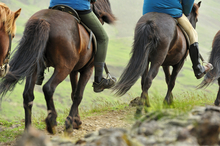Trail riding is great therapy for the mind of human and horse! We are reinvigorated by the vistas, the smells and the quietness we experience while on the back of our horses on the trail.

Staying safe while trail riding
Trail riding is great therapy for the mind and body of human and horse, and careful preparation can prevent a potentially wonderful experience from turning unpleasant.
Horses seem to sense our exhilaration at being one with them on this adventure. Careful preparation can prevent a potentially wonderful experience from turning unpleasant.
Don't fail to consider the following possibilities when riding some distance from home.
- Keep tack well maintained. A piece of leather strap can be tied to the side of your saddle to be used to repair bridle or saddle in case of breakage.
- Horse hobbles should only be used on horses previously trained to wear them.
- Carrying a halter and short rope will allow safe grazing when the bridle is removed.
- Clothing is of primary concern. A jacket tied on the saddle will save you from discomfort due to sudden climate change.
- A slicker with water proof fishing gloves and a rain hat are appreciated when it storms.
- Long underwear will prevent chafing when you haven't ridden recently.
- Wear boots that are safe for riding but that will allow you to walk comfortably if it becomes necessary.
- Be sure to tell someone where you are going and when you expect to be back.
- Riding with another person is not only safer but also can be a very pleasant way to enjoy one another's company.
- Carrying a canteen full of water is always wise.
- Take any medicines that you might require if you are delayed.
- Carrying a snack bar or other compact ready-to-eat food is a good idea.
- A small human first aid kit and a pocket knife, wire cutters or a versatile Leatherman tool are essential. So many times we run into old fencing that may become a wire trap on or near the trails. If your horse becomes entangled you will want a quick way to free him.
- When we ride in the forest we like to carry an axe or saw to clear away downed trees that can block the trail.
- A horse first aid kit might include some antibiotic salve, a roll of Vetwra p, a large bore syringe case (in case of snake bite on the nose), needle and thread, extra horseshoe nails and a pre-shaped horseshoe, or a spare tire hoof boot.
Hoof boots must fit perfectly to be effective, otherwise, they may be lost or rub the horse raw and make it lame.
Boots are generally unacceptable when the going is extremely variable as in the case of deep mud or sand. For short distances boots may be a useful protection, but for long distances they are often unsatisfactory. The technology of boots has improved greatly in recent years but they are still expensive, clumsy and are not always the most ideal solution for more frequent riding.
I love to trail ride. It is good for the mind and the spirit of horse and man!
Doug Butler PhD, CJF, FWCF
Doug Butler, PhD, CJF, FWCF, has been an equine educator for over 50 years and is the co-founder of Butler Professional Farrier School near Chadron, NE
To learn even more of the Butler Team's best strategies for keeping your horse safe, healthy and sound, check out their latest book, Essential Principles of Horseshoeing.
